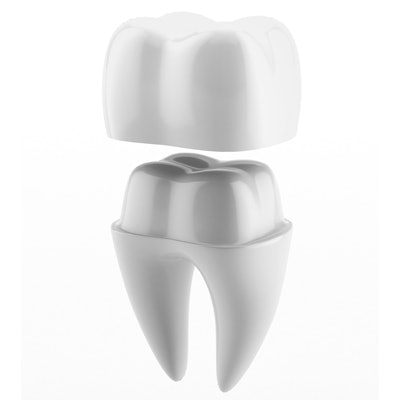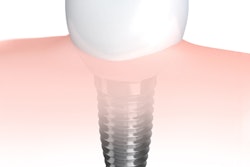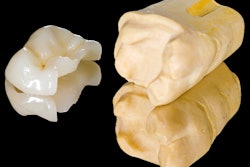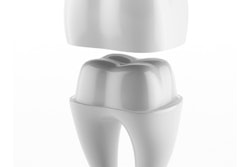
When you are preparing a single-unit crown for a restoration, which clinical details matter? Researchers used data from more than 3,400 crowns to identify the factors that influence treatment decisions, and they found that three factors were associated significantly with the decision to bond single-unit crowns.
"Excessive occlusal tooth preparation, anterior location of a crown, and the use of glass ceramic crowns were associated significantly with the decision to bond," wrote the study authors, led by Nathaniel Lawson DMD, PhD (Journal of the American Dental Association, April 25, 2019). Dr. Lawson is an assistant professor in the department of clinical and community sciences at the University of Alabama at Birmingham School of Dentistry.
Bonding
Self-adhesive resin cements constitute a subcategory of resin-based cements that are capable of bonding with the tooth structure. This is where the phrase "bonding a crown" comes from, as a hybrid layer is formed at the tooth-cement interface, the authors wrote.
The researchers' main outcome was the dentists' decision to bond the crown (use of a resin cement or self-adhesive resin cement) or not (use of another type of cement). They also wanted to determine if factors related to crown retention (preparation taper, occlusal reduction), crown strength (occlusal reduction, axial reduction, material choice), or tooth and margin location were associated with the use of resin (bonding) or water-based acid-base cements (nonbonding).
The researchers used data from more than 200 dentists in the National Dental Practice-Based Research Network from March 2016 until February 2017. All patients were at least 18 years old.
These dentists recorded clinical details, including cement type, used for more than 3,400 single-unit crowns. If a dentist used a resin cement, the crown was classified as bonded (see table below).
| Percentage and number of crowns that were cemented (n = 3,468) |
|
| Cement type | No. of crowns (%) |
| Resin: Bonded | 1,321 (38.1%) |
| Resin cement | 1,013 (29.2%) |
| Self-adhesive resin cement | 308 (8.9%) |
| Acid-Base: Nonbonded | 2,147 (61.9%) |
| Resin-modified glass ionomer cement | 1,811 (52.2%) |
| Glass ionomer cement | 286 (8.2%) |
| Zinc phosphate cement | 50 (1.4%) |
Almost twice as many dentists (79 of 202) never bonded a crown than bonded every crown (41 of 202), the researchers found.
More than 38% of crowns were bonded, they reported. The material also mattered. They found the following bonding percentages for the different materials:
“One surprising observation was that 60% of dentists did not vary their cement selection for any of the crowns cemented within the study.”
- More than 76% of crowns fabricated from leucite-reinforced glass ceramic
- Almost 71% of crowns from lithium disilicate
- Almost 39% of crowns from layered zirconia
- Just over 30% of crowns from full-contour zirconia
- Almost 15% of full-metal crowns
- Almost 4% of porcelain-fused-to-metal crowns
In addition, crowns with excessive occlusal reduction were more likely to be bonded (p = 0.02), but the researchers found no association with bonding and excessive taper (p = 0.15) or axial reduction (p = 0.08).
They also reported no significant association between the choice to bond and crown margin location (p = 0.35), but they did note that crowns in the anterior maxilla were more likely to be bonded (p < 0.01).
Two aspects of the study results surprised the study authors, according to Dr. Lawson.
"One surprising observation was that 60% of dentists did not vary their cement selection for any of the crowns cemented within the study," he wrote DrBicuspid.com. "It was also surprising that crown margin location and excessive preparation taper were not associated with the decision to bond a crown."
Consider the results
The authors noted several study limitations, including that the analysis assumed that all crowns that were placed with a resin cement were bonded. It is possible, they wrote, that a dentist may have used a resin cement without the intention of bonding the crown.
They were also aware of a level of subjectivity in the evaluation of the crown preparations and location of the gingival margin because of the use of different clinical evaluators. Errors from clinicians incorrectly categorizing their cements may have occurred as well, the authors added.
Nevertheless, the study authors hope dentists will consider their results when treatment planning, according to Dr. Lawson.
"The most predictive factor related to cement selection within this study was related to the type of restorative material used for the single-unit crown," he wrote.
He noted that particular crowns were more likely to be bonded than others.
"Leucite reinforced glass-ceramic and lithium disilicate crowns were much more likely to be bonded than zirconia or metal-based crowns," Dr. Lawson wrote. "Excessive occlusal reduction was another factor associated with the choice to bond a crown, likely due to the increased need for retention with an overreduced crown preparation."



















